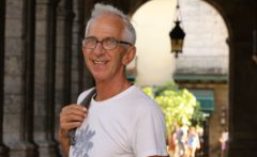Tomorrow I arrive in Cuba, at Terminal 3 of the José Martí International Airport in Havana. It´s the eighth time, and each time I´m filled with a mixture of nervous anticipation, fear that something unexpected will go wrong and excitement. It´s another world!
Usually, flying from Australia I pass through US Customs in Los Angeles, and change flights for Mexico City, and from there to Havana. This time, for something different, I am in Panama City, and leave from here at 9.15 in the morning.
I first came to Cuba in 2002, not so long after the breakup of the Soviet Union in 1991 and the worst of the “Special Period” that followed, when Cuba´s economy collapsed without Soviet support, and oil became desperately short. One of the reasons for going then, was a fear that this little Caribbean Island that had resisted bullying and terrorism from its northern neighbour for so long, would inevitably succumb, and become another Coca Cola colony of the USA, like Puerto Rico. While it would gain the benefits of capitalism, it would be at risk of losing some of the unique and precious things that distinguish it from other latin countries, including its vibrant culture and its public health and education systems.
I have seen many changes since 2002, while many things have stayed the same. With the thawing of relationships with the USA, there are big challenges for the Cuban government. Within months of the meeting of Presidents Obama and Raul Castro in December 2014, the numbers of US tourists to Cuba soared, bringing much needed money into the economy.
When nobody had anything much and there was an identifiable external threat, the Cuban people put up with their plight, banded together and put the country first. If the influx of tourists and money, means that some Cubans get relatively rich, while most others continue to struggle, the situation may change.
I will report on the changes that are occurring, from the perspective of a “yuma” (white western foreigner) and from the perspectives of Cuban friends while I spend the next two months in Cuba.
Despite the easing of tensions with the USA, the US economic blockade (embargo) remains in place – and could only be removed with the support of the Republican controlled US Congress. For 23 years, the United Nations General Assembly has voted overwhelmingly to end the blockade, with 188 nations including Australia and Britain, now demanding that it be removed, and only the USA and Israel supporting the crippling sanctions.
Cuba claims that the blockade has cost it more than $1,000 billion, while the USA disingenuously alleges that Cuba´s economic problems are due its own mismanagement. Despite the opening of embassies in each other´s country this year, the blockade has been tightened in recent years, and is unchanged. Severe penalties prevent industries in countries that oppose the blockade doing business with Cuba, such as Australian banks. (https://www.facebook.com/UnfairANZSanctionsHurtCubans/).
Tomorrow, as I join the throng of “yumas” on their way to Cuba, I can reflect on others who have been drawn to the island before me. In recent times, famous personalities like Beyoncé, Ry Cooder, Wynton Marsalis, Juanes, Jack Nicholson, Kevin Spacey, Naomi Campbell, Jodie Foster, the queen of Spain, and Spanish actor Javier Bardem, have been. In 1987, Australian group Air Supply gave a massive concert, and are still remembered fondly. Perhaps the most famous Cuba-phile was Ernest Hemingway, who lived there from 1939 to 1960, and his home, Finca Vigia, is a Hemingway Museum (also, there are so many places in Old Havana that claim that “Hemingway drank here”, that one great little restaurant, El Chanchullero, has a sign saying that “Hemingway never came here”). Long before them, a gay Prussian aristocratic scientist, the father of geography, left a lasting impression. Baron Alexander von Humbolt visited Cuba in 1800 and again in 1804, and has been called the second discoverer of Cuba for his geographical studies. He is remembered by a street in Vedado, curiously where a smart, modern gay venue has opened “Humboldt 54”, and his statue and a museum are to be found in Old Havana. I´m keen to visit them.

